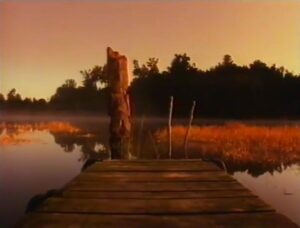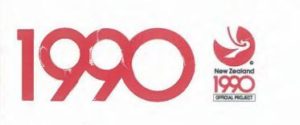1990: Who Are We
January 2, 2022
By AHNZ

Imagine a New Year where Anglo-Zelandians and Polynesian-Zelandians responded to and connected to a love of their country. So much so that patriotism and values were an appropriate package to sell us financial services. Such a new year was 1991. We are fortunate to be able to replay this video history from director/narrator Len Potts and musician Murray Grindlay. It’s a great contrast to how governments and corporations try to sell things to us these days.
Reputation has always been important to banks and they have had large budgets to promote those reputations. In the old days banks projected a brand of stability and trust and security in their architecture. We still have old bank buildings standing today. For example, this sturdy Bank of New Zealand building in Dannevirke (1887) or the Bank of Otago (Former) (1870.) Ohakune’s landmark giant carrot was created for one ANZ bank advertising campaign. ANZ could afford to do that but Ohakune couldn’t so a bank’s cast-off second-hand prop was gifted to the town for an icon.
2008: Kiwibank adversing struck its chord framing the bank as heroic underdog taking back the country from foreign invaders using trench coats, fedora hats, and Morse code. It was a sort of re-imagined French Resistance. “We” were winning, “we” are taking control of our own interrogation.
2019: Ten years on Kiwibank’s big advertisement has been centred on ‘Kiwi Kath’. She’s the walking personification of everything kitsch and cliché about NZ; An anthropomorphic MacDonalds Kiwiburger wrapper! Ref. 2008: Join the Resistance, AHNZ
The ‘Who We Are’ campaign created in 1990 met a high point in New Zealander’s self-respect. Len Potts and Murray Grindlay hit that nail squarely on the head.
 1990 was a massive national sesquicentennial anniversary. A travelling expo toured the country that was 150 years old now. Our government commissioned two Anzac-class frigates and built much of them here in New Zealand. Sunday Trading began. TV3 began. The Queen came. We hosted the Commonwealth Games. Kiri Te Kanawa put on a landmark show to high approval. Rachel Hunter at Tip Top Trumpet on TV. The painful 1980s transition was over and we were a new and confident New Zealand.
1990 was a massive national sesquicentennial anniversary. A travelling expo toured the country that was 150 years old now. Our government commissioned two Anzac-class frigates and built much of them here in New Zealand. Sunday Trading began. TV3 began. The Queen came. We hosted the Commonwealth Games. Kiri Te Kanawa put on a landmark show to high approval. Rachel Hunter at Tip Top Trumpet on TV. The painful 1980s transition was over and we were a new and confident New Zealand.
And we got this Len Potts BNZ advertisement terminating in a proud blue national flag waving on our TV screens.
This was the context for these commercials and why they are so different to anything we have seen for a very long time now.
“Len’s was the voice on these ads, which he also wrote. As I sit here playing them over and over, my geese are bumping and my eyes are leaking.
(The astonishing tune was provided by Len’s musical equivalent Murray Grindlay.)
In an age when New Zealand film and comedy was still finding its feet, Len used the medium of commercials, like the Crumpy & Scotty series for Toyota HiLux, the “Sailing Away” song for the America’s Cup, and the classic Nilverm “Aussie sheep” spot, to introduce New Zealand to itself.
He was the master distiller of the story. Barry Crump had 300 pages of novel in which to spin his yarns, John Clarke his long skits and longer playing records, Billy T James his one-hour comedy shows, and Geoff Murphy and Roger Donaldson their two-hour movies.
Len had 60 seconds, max. (In which time he also had to plug a product without sounding crass.)
Few would disagree that Len Potts was the greatest New Zealand advertising man, bar none.” – John Ansell, Facebook (2016)
—
Ref. 1989: The Palmer Interlude
6 thoughts on "1990: Who Are We"
Leave a Reply
 Like Comment Share
Like Comment Share






Rick, people per-se become sentimental patriots when the admen pour on the colourful schmaltz along with words and music to set the scene. Recently I’ve watched affluent kiwis urged to be the first to buy Pure New Zealand Manuka Honey at $2000 for 250 grams and enjoy the wonderful healing qualities peasant honey can’t provide. Thats money in the bank in anyones language.
MEMORIES FROM 48 YEARS AGO.
I was working on construction sites in and around Wellington in the early 1970’s and watched first hand the fiasco of the BNZ on Willis Street as it rose out of the deepest foundation hole I had ever seen dug to accommodate a giant 27 story steel tower the bank was to become.
It was all reclaimed land, which was once festooned with wharves and wooden sailing ships. Many treasures were discovered as the hole bored deeper into the ground. At the time I was working on the construction of the CML insurance building on the corner of Williston Street and Victoria Avenue. The site was across the road from the BNZ and as our foundation went deeper into the historic sea front, I found several honey coloured ceramic ink pots which I suspect had been thrown overboard from sailing ships of old.
I think I spent as much time watching the waste coming out of the hole as I did watching what was going into it..
But as the BNZ started to grow out of the ground, so did its troubles.
Apart from any engineering difficulties associated with building a massive steel structure more at home on a New York skyline than Wellington NZ, the biggest problem came with the relationship between the Australian construction company (Civil and Civic) and the then Wellington Boiler Makers Union headed by local hard man Con Devitt.
The construction was plagued by constant unrealistic demands from the all powerful Boilermakers Union. A union considered by many to be no more than an organization run by thugs masquerading as a socialist workers welfare institution.
With the first sign of rain, work would stop and not resume for at least an hour after the last drop had fallen. From a safety perspective there was no argument considering the welding work being undertaken, but it went to extremes and the standing joke was the boilermakers had a direct line to the Metrological Office which alerted them to any incoming nimbus nectar.
Apart from the hefty pay packets the boiler makers took home, stories flowing down to the construction hoi poloi told of boilermakers enjoying lavish smoko facilities resplendent with lounge and dinning furniture complemented with kitchen service provided by a full time staff member employed to meet the union members needs. The boilermakers were the envy of workers on every building site in Wellington.
The massive cost overruns and delays associated with union involvement with the build, was a reason among many why Civil and Civic packed up business in NZ and went back to Australia.
Muldoon’s Government eventually deregistered the union and I believe Devitt was convicted of some degree of fraud in connection to union activity , but the passage of time appears to have erased that memory from our history.
Completed in 1984, 6 years longer than planned, the bank building was quickly sold by the Lange Labour Government under the guise of Rogernomics and a new breed of get rich quick merchants urged on by the labour Government, fleeced NZ taxpayers yet again.
Thanks for that. I don’t accept that advertisers create the sentiment. They stoke the sparks already there and there are more to go after at some times than at others. Advertising brands from the 1990s would not be attempted today.
eg. Check out how Milo was being sold here
http://ahnz.anarkiwi.co.nz/1971-new-zealands-heritage-the-making-of-a-nation/
You might like this
https://ngataonga.org.nz/collections/catalogue/catalogue-item?record_id=147249
I noticed in Len Potts brilliant piece of Kiwiana re the BNZ of 30 years ago is his reference to “Aotearoa New Zealand.'” The lyrical use of “Aotearoa” is not out of place and flows along with the music and narrative.
But in 2023 the use of “Aotearoa” in place of New Zealand is for many, considered bad language. I suspect it’s because the change is being forced on the country rather than by consensus.
During my travels in foreign lands, strangers have recognised the Kiwi emblem I wore, before they related to my country of origin.
Thankyou John Hurley, you made me laugh on a drab day in the Tararua which is either in the Northern Wairarapa or the Southern Hawkes Bay depending on your preference.
47 years on, the political promises and results remain the same and the only thing different are the quality of cartoons and the talking heads delivering the message.
The difference is that Aotearoa used to be for everyone. It has now been politicised. It has been appropriated for the Conformity Identitarian group. Part of how that group stake their claim is by retroactively pointing to people in the past (eg Len Potts, Ken Cumberland, Pember Reeves,..) using the name as if they were part of the same continuity. They were not. This is new.
Politicisation ruins everything in the long run for the sake of getting a drug hit of power and money in the short run. Politicians will pick it up and run it out, discarding it when they’ve used it up.
A recent example of politicisation is the branding of the woman’s rugby world up in 2022. Many of us have no issue with rugby or womens’ rugby yet the promotors decided to couple it with up with the strange amalgamation of transexual Maori poi dancing. So, you have to like both in order to like one because it was a package. If you don’t want to get down and boogie with transexual Maori poi dancing you’re excluded from woman’s rugby. Likewise, if you don’t sign up to the new ‘Aotearoa New Zealand’ culture then you don’t get to use the word ‘Aotearoa’ any more because They have taken it off you.
Ref. https://www.facebook.com/watch/?v=1274185166734480
The Poofs of Poi are good for a laugh but they spin no wheels on my drag strip.
Used to have a 69 Cadillac Eldorado which we affectionately named the “Kiwi Caddy”.
We replaced the white vinyl on the roof with a stylized paua shell print which we tinted with a touch of purple to blend with the Crazy Cracked Plum paint job.
From the rearview mirror we hung a pair of colourful poi complimented with a 1970 Air New Zealand plastic tiki. The paua motif was replicated on the internal doors and dash.
On the enormous bonnet we replaced the Cadillac symbol with a polished metal and paua shell Kiwi sculpture.
Kiwiana at its best.
In the Hawkes Bay lives a talented artist I’ve had the pleasure of knowing for over 30 years. Her name is “Jill of Aotearoa.” I have never known her by any other name. The lady needs no one’s permission to be who she is.